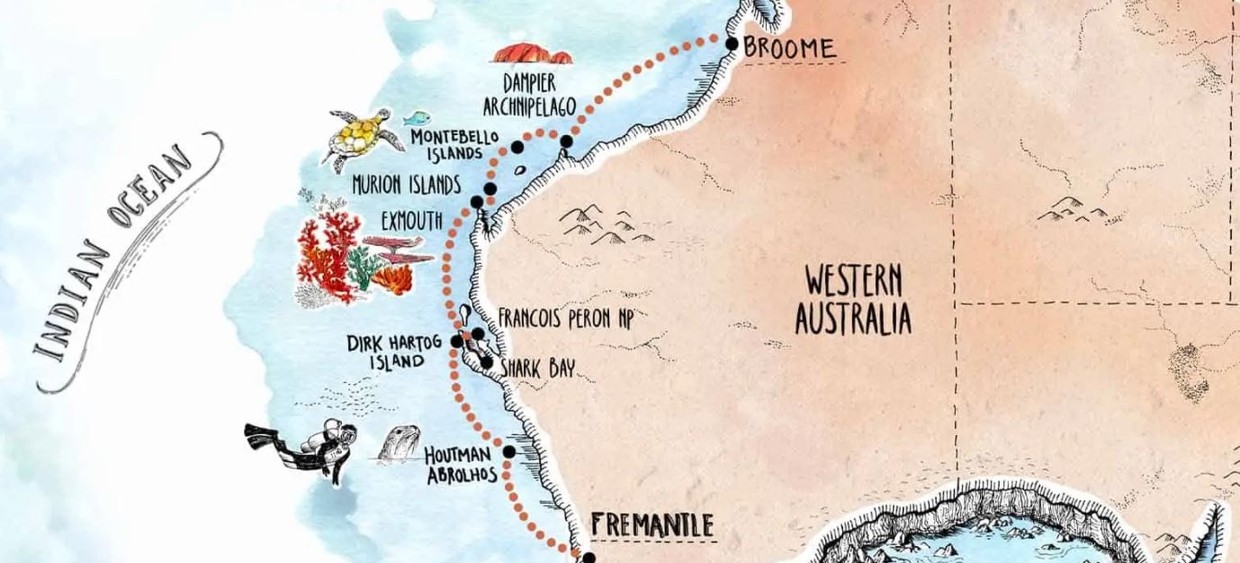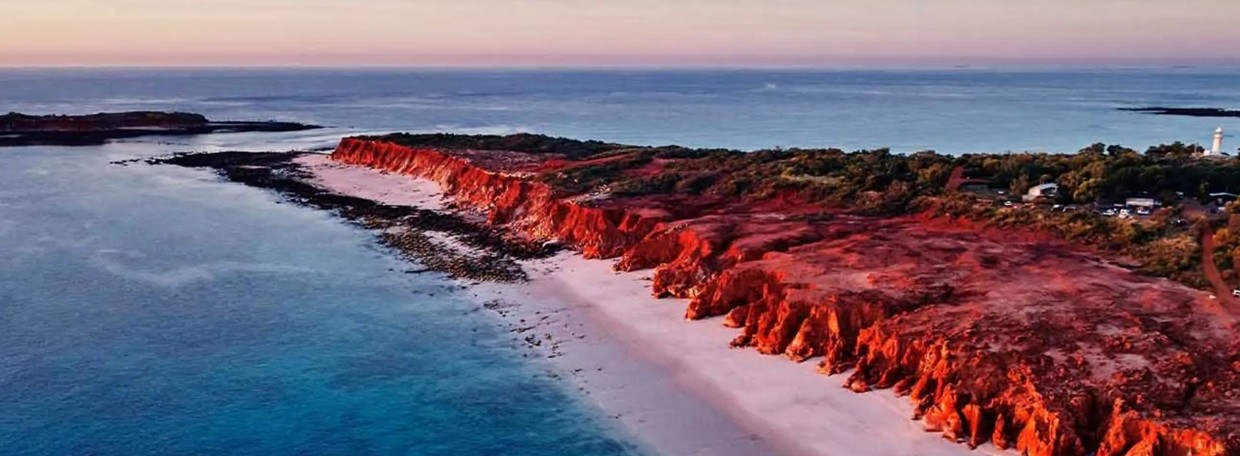from$ 9570 AUD
Note: Current p/p indicative rate. Final price may change due to currency fluctuations.
Coral Geographer
Broome to Fremantle
Overview
This expedition explores Western Australia’s wild and largely untouched coast, with its contrasting coastal palette of rich red sands and turquoise sea. With a fascinating maritime and Indigenous history – from the Malgana people of Shark Bay to the exploratory journeys of William Dampier, Dirk Hartog, Baudin and Freycinet – this region is layered with stories. The natural coastal reserves harbour an abundance of birdlife and fascinating marine species. Our guides will help guests explore the renowned Houtman Abrolhos Islands, Shark Bay World Heritage Area, Ningaloo Reef, Cape Range National Park, Montebello Islands, Muiron Islands and Dampier Archipelago.
Departures
Cruise Itinerary
Board at 4pm Broome. There is time to settle into your stateroom before our 5pm departure. Take the time to become acquainted with all the facilities onboard. As dusk falls meet your fellow travellers, the Captain and crew for the Captain’s Welcome Drinks.
Consisting of 42 islands and islets, 25 of which are nature reserves, the iron red islands of the Dampier Archipelago stand in bright contrast to the turquoise waters which surround them. The archipelago not only offers exceptional natural beauty but significant sites for Aboriginal and European Heritage, many of which are in National Heritage Listed Areas. Named for English Explorer William Dampier who first visited the islands aboard the Cygnet in 1699, the islands’ earliest inhabitants were the Yaburara people, as is evident by thousands of rock engravings, shell middens and stone arrangements scattered across the area. Search for ancient aboriginal petroglyphs on remote island beaches, swim in the vibrant blue water or paddle out for a leisurely kayak. We will also take some time to enjoy bird and wildlife spotting – bottlenose dolphins are regularly seen in this area, alongside the archipelago supporting the largest hawksbill turtle rookery in the Indo-Pacific region. Birdwatchers will have the opportunity to see several species of migratory waders as well as sea eagles and ospreys. With some luck we may even see the elusive Rothschild’s rock wallaby.
The Montebello Islands or ‘Montes’ are an archipelago of more than 250 limestone islands and islets off the coast of the Pilbara. Much delight for the birdwatchers among us, the islands are considered an Important Bird Area, as they support over 1% of the world populations of fairy and roseate terns, as well as Sooty Oystercatchers. The Montes have an ‘explosive’ past. Alpha and Trimouille Islands were the site of three British atomic weapons tests in the 1950s. Relics of the military operation can still be found on the islands today. We will visit the plinth, which marks Ground Zero at Trimouille Island, where now you will find a haven for wildlife, including the rufous hare wallaby. A fascinating maritime history surrounds the Montebello Island. Survivors of the Dutch vessel Trial swam here after their ship was wrecked in 1622, therefore being the first Europeans to land on the islands. We will spend a full day exploring this island group, including wildlife spotting opportunities and beautiful beaches to enjoy a swim. See the rare rufous hare wallaby and lagoon rays while exploring amazing vistas.
The Muiron Islands are located approximately 10 nautical miles off the North West Cape. The Islands are well known for their incredible reef, colourful soft corals, an abundance of turtles, schools of fish and even sightings of manta rays! A variety of dive sites are on offer at this destination, including swim-throughs and ledges where nudibranchs, eels and angelfish hide. With fantastic bommies and protected reef, snorkellers will appreciate the variety of soft corals and gorgonians as well the incredible fish life. Birdlife is abundant onshore – see if you can spot wedge-tail shearwaters, roseate terns, osprey, and black-shouldered kites (just to name a few). The World Heritage listed Ningaloo Reef is the turquoise jewel in the crown of the Western Australian coastline. Spanning over 5,000 square kilometres, this is one of the largest fringing reefs in the world. It’s inner and outer reefs create a diverse range of habitats for vibrant corals and more than 500 species of fish. This is also where mega marine life come to feed during their migrations, including humpback whales, giant manta rays, and the majestic whale shark. It is also a coastline with a fascinating heritage, where lonely whalers battled it out against the elements. After in-water activities, stretch your legs on a stroll down the beach on these untouched islands.
One of the longest and most pristine fringing reefs in the world, Ningaloo Reef has an unusually narrow continental shelf. The deep oceanic waters, reef and coastline communities are close in proximity, resulting in a huge array of significant and healthy marine life coexisting in one area. Over 200 coral; 500 fish; 650 molluscs; 600 crustaceans; 1000 marine algae; 155 sponge and 25 echinoderm species are found on this shelf, slope and in deep-sea habitats, many of which are new discoveries and endemic to the area. The Ningaloo Coast is also one of the most important turtle nesting rookeries in the Indian Ocean. The Ningaloo Coast also has a significant maritime history from explorers, traders, pearl luggers, whaling and fishing. Spend the day at Cape Range National Park with options to snorkel at Turquoise Bay, visit Yardie Creek via a 1.2km Nature Walk, head up to the Vlamingh Head lighthouse or visit the Milyering Discovery Centre. There will also be some free time to explore Exmouth.
Spend two days exploring the Shark Bay World Heritage Area, the first location in Western Australia to receive UNESCO World Heritage status in 1991. This is a region of colourful landscapes, rare flora and fauna, and home to a staggering 35% of all of Australia’s bird species. Explore Francois Peron National Park, named after the naturalist on explorer Nicholas Baudin’s expeditions. We visit Dampier’s Landing, where William Dampier came ashore in August 1699, describing the vegetation and making the first scientific collection of Australian plants. He also named Shark Bay, and 300 years later, a plaque was erected at this site in his honour. In the afternoon we will snorkel at Louisa Bay coral communities about 200m from shore. Cabbage corals dominate this area, but there are also staghorns and massive pocillopora and pink pocillopora species. Spot reef fish including coral trout, blue-lined emperor, scribbled angelfish and the fully protected potato cod. Off Sandy Point beach there is a Marine sanctuary zone, which protects a diversity of staghorn, brain and plate corals.
The Abrolhos Islands consist of 122 islands, clustered into three main groups, the Wallabi, Easter and Pelsaert Groups. Lying in the steam of the southward flowing Leeuwin current, the marine environment here is a meeting place for tropical and temperate sea life. Common marine mammals include Australian sea lions and bottlenose dolphins, and over 90 species of seabird have been identified. The treacherous reefs around these islands have claimed many wrecks over the centuries, the most famous being the Batavia in 1629 – whose Dutch crew swam ashore only to experience a brutal mutiny. The Abrolhos islands offer a near-pristine natural environment with a diverse range of marine and terrestrial fauna and flora. This area also offers a rich history including shipwrecks and remnants of early colonial industries such as guano mining and commercial fishing. A broad range of available activities includes visiting historical sites, fishing, wildlife viewing and world-class diving and snorkelling sites. The Australian sea lions love to swim and play with snorkelers and divers here. We visit Liddon Pearls on Post Office Island in the Pelsaert (Southern) group of the Abrolhos. Here we learn what is involved with growing the pearls, learning the different shells and pearl categories, and how the different types of pearls are set. We will also have insights into the renowned cray fishing industry of the island, from the family who has been in the Abrolhos for 4 generations. Later is the opportunity to snorkel the blue holes from the jetty, or even the reef where our local guides will take us to the best spots for coral, fish, dolphins, squid, seals and other marine wildlife.
Arrive in Fremantle at 7:30am for an 8:00am disembarkation.
Itineraries are subject to change.
Coral Geographer

Vessel Type: Expedition Passenger Capacity: 120 Built: 2020 Expedition capabilities > Two trademark Xplorer tenders seat all passengers and facilitate comfortable shore excursions > Six zodiacs for more intrepid exploration > Lecture lounge for daily expedition briefings and expert presentations > Small onboard library featuring books on destinations and wildlife > Shallow draft and advanced navigation and propulsion systems allowing access to locations closed to large cruise ships Marine immersion > Navigator lounge in the bridge > Over 1000 square metres of open deck space including a wrap-around promenade deck with panoramic views > Engine room tours and a high level of crew interaction with guests Food and wine features > Single seating dining with communal table serves buffet breakfast and lunch, and multi-course table d’hote dinners > Showcase galley with viewing window creating fresh small-batch cuisine featuring Australian and local produce > Multiple indoor and outdoor bars, including our Explorer bar on the sundeck for sunset drinks > Curated wine cellar featuring boutique wines and exceptional vintage Australian reds Guest comfort > All outside-facing guest cabins with en-suite bathrooms; the majority have a private balcony > Active stabilisers to dampen sea motion > Well-equipped gym > Passenger elevator > Wi-Fi available in all guest areas
Highlights
• Discover the fascinating history and natural wonders of the Abrolhos Islands, as you swim with friendly sea lions and snorkel over the fringing reefs • Explore World Heritage Shark Bay with visits to Francois Peron National Park & Dirk Hartog Island, to discover the history and abundant wildlife of this region • Discover World-Heritage listed Ningaloo Reef with scuba diving and snorkelling at outer reefs and from the beach at Turquoise Bay • Discover sites of cultural significance to Indigenous Australians, including the Dampier Archipelago petroglyphs, with expert interpretation • Learn about the coast’s fascinating maritime history – the wrecks of the Barque Stefano off Northwest Cape, the Trial near the Montebellos, and the Batavia at the Abrolhos • Birdwatch at the Muiron Islands and Montebello Islands, known for their large populations of nesting seabirds
Map



